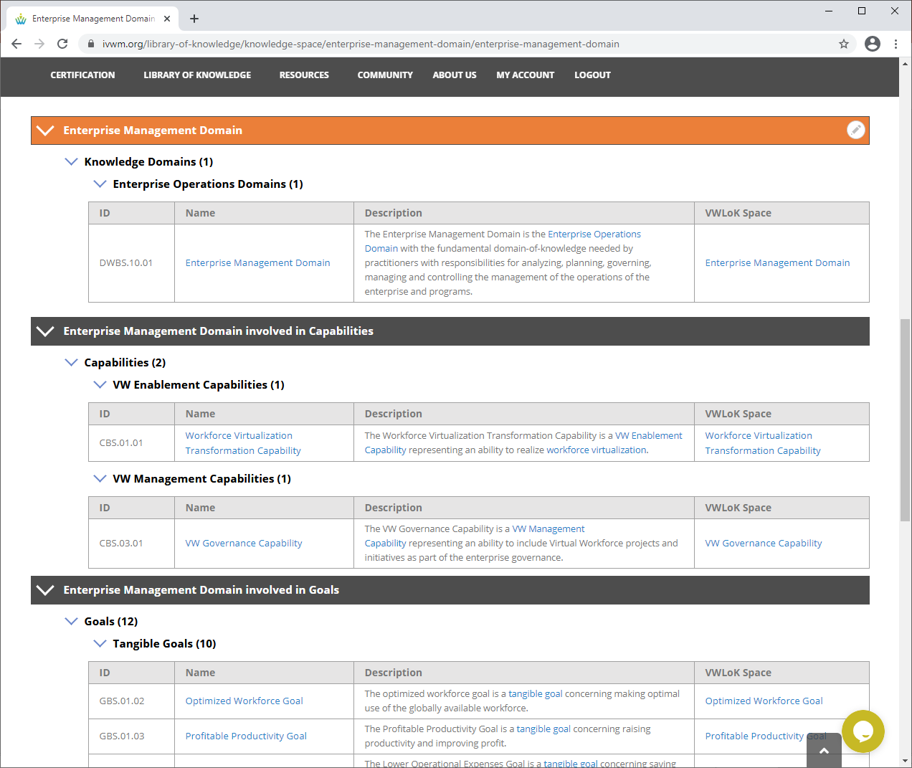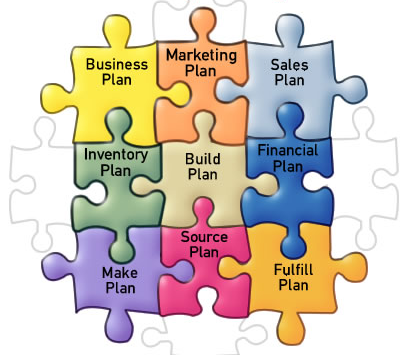
The Virtual Workforce Library of Knowledge is setup to guide practitioners in meeting their interdependencies, within their process activities, based on work products produced by a practitioner and used by others.
In this way the Library is setup to guide executives, an enterprise architecture team, business managers, and other leadership positions, through a prescribed order of Knowledge Spaces. The ordering of the topics is focused on developing a top-level understanding of the complex path to realizing virtual workforce capabilities. This is the first step in realizing a scalable and sustainable virtual workforce, a complex business transformation.
Navigating this path supports executive evaluation and decision making, aimed towards realizing workforce virtualization. Beginning the efforts by gaining enough knowledge and experience with the use of the Library, to make decisions concerning their organizations moving forward with the use of it, and the ability to do their, and their organizations work towards realizing workforce virtualization, and the ability to govern the situation and efforts, if the decision is made to 'go virtual'.
Workforce virtualization is the transformation to a business model, utilizing a virtual workforce, within a virtual working environment, to form capabilities, designed, developed, and operated, using processes, information, and technology, optimized for satisfying the needs of working virtually.
The virtual workforce can be considered a group of people, who utilize virtual technology systems in varying degrees, working regardless of relational, locational and temporal boundaries, in order to accomplish an interdependent task. The decentralization of the workforce was made a necessity through the globalization of the work process, and accelerated through the high speed of development in information and communication technologies.
The rate of people working from home has increased in the corporate world by 140 percent since 2005. Remote Year and CO found that 55 percent of workers worked fully remotely during business hours. An additional 43 percent stated that they worked remotely during some part of the workday while spending the rest of that time on site.
Corporations are leaning towards the virtual workforce as a means of cost savings as well. Businesses report expense reductions in overhead (insurance, rent) and inefficiency (time spent driving to work, late lunches) when using remote workers domestically and even less when contracting out to a virtual workforce across the world. For instance, Enola Labs reported that it would save 77 hours per day if it could eliminate commuting from day-to-day activities.
Dell reported that moving into a more virtual workforce saved the company $12 million per year in office space costs alone. Municipalities are also using virtual workforces, with 60 percent of tech jobs in Austin, Texas, going to workers outside of the state. San Francisco has 30 percent of its jobs going to people who work remotely outside of the city.
Many surveys have also reported that working off-site actually improves the efficiency of laborers in many industries. Surveys of the marketing industry, for example, show that 80% of creative marketing professionals would rather work virtually than on site. This high number of would-be digital nomads also crosses over into the engineering space, with 76% of surveyed engineers saying that they would rather work remotely.
The trend towards virtual workforce capabilities extends beyond the enterprise landscape into the world of startups as well. 56% of startups across the world report having outsourced to virtual workers, which greatly increases the need for these workers in many countries.
Capabilities are collections of people, process, information, technology and other resources which together function to realize a value-added ability to satisfy a customer-based need, in order to accomplish the goal of serving the enterprise mission and sustaining the existence of the enterprise.
Virtual workforce capabilities are realized by collections of working resources used to satisfy virtual workforce needs.
The lead roles manage and control the realization.
The flow of the work products between the processes, with outputs of one process being the inputs to others, creates interconnections with interdependencies. Interdependencies create issues when work product deliveries are poor quality, late, incomplete, misdelivered, totally missed, lost, or worse yet, unknown to be needed, by the producer or the users.
To be successful lead roles must follow the work products through the SOP activities, in order to keep the flow of work under control, achieving goals, and accomplishing the mission.
Therefore, relative to the use of knowledge domain and capability Knowledge Spaces, and using the VWLoK metadata reporting of relationship data to other resources, the most important reports are the "uses SOPs" (activities), the "uses work products" and "produces work products" reports, as the reported SOPs define the associated cross-functional work to be accomplished, and the reported work products define the expected outputs, forming the interconnections and interdependencies between the processes/lead roles/knowledge domains.
With this understanding of "capabilities", preparations for implementing virtual workforce capabilities can begin, leading to subsequent capabilities needed in fully realizing virtual workforce capabilities.
To realize virtual workforce capabilities, starts with implementing a workforce virtualization transformation capability, and through the metadata related to this specific virtual workforce capability, to know what knowledge domain expertise is involved in the capability,
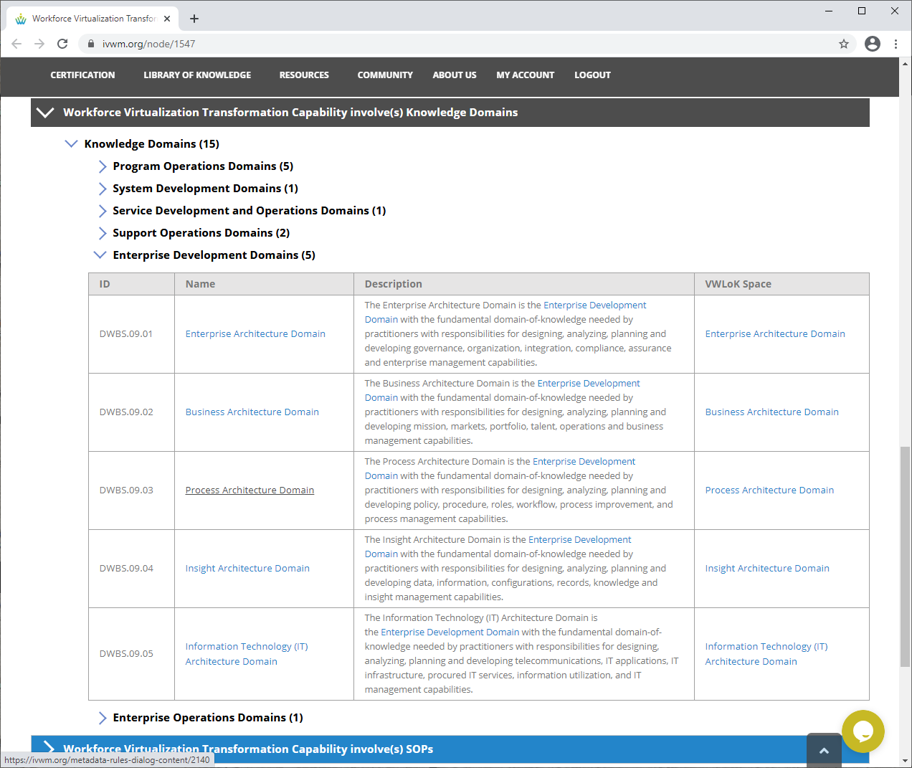
and to understand all the roles and responsibilities of the architects, managers and executives.
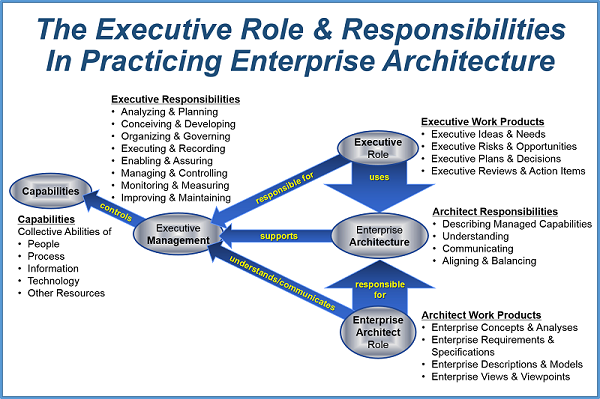
Process activities begins with transformation analysis and planning by the enterprise architect, of the enterprise architecture knowledge domain, producing the 11 enterprise design work products needed as inputs to the other processes of the other knowledge domains.
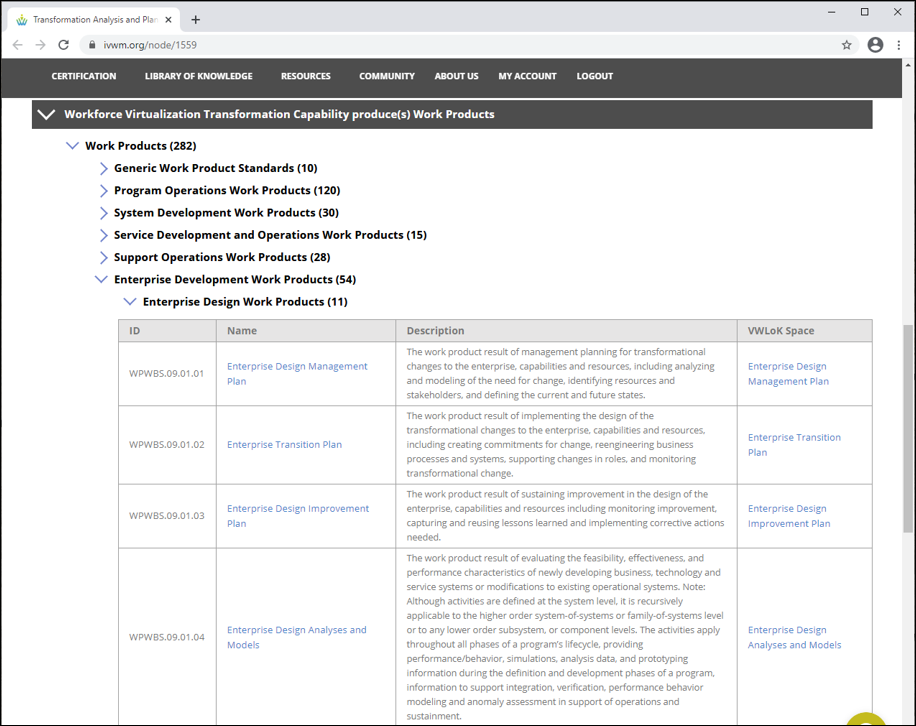
In other words, these work products are the interconnections and interdependencies between the team members realizing the workforce virtualization transformation capability, involving executive analysis and planning activities and resultant work products which drive the realization of all subsequent VW capabilities.
For example, from the work product metadata popup windows, the enterprise design work products shown above, are shown to be produced by the enterprise design process to be used by the other processes involved in the capability, for example, the enterprise design transition plan being used by the enterprise management process in the development of the enterprise management plan.
Through the metadata related to this specific virtual workforce capability, the enterprise manager (i.e., executive), and all other lead roles involved in the capability know to what extent the enterprise management plan serves the needs of the capabilities it is involved in, through the process which produces it, and the SOPs involved.
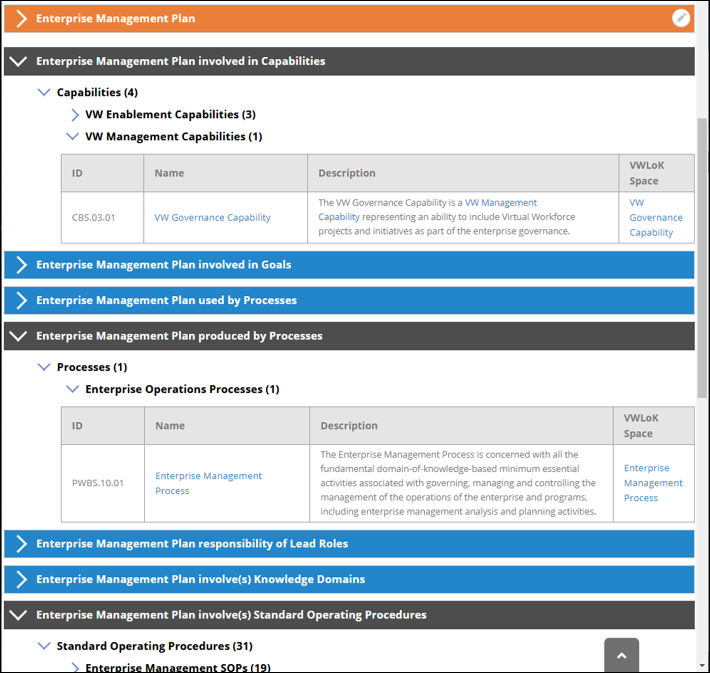
In this way, all lead roles needing the enterprise management plan as input to their efforts, know the enterprise management process produces it, and involves the enterprise management domain knowledge, of the enterprise manager (executive), and in this way, leads in turn, to everybody knowing what everybody needs to do,
